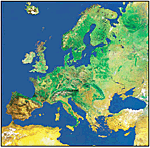Topic 1: Physical Geography of Germany

Lesson 1: What is Germany’s location in Europe?
Lesson Objective
The student will locate physical features of Germany and Europe on a satellite photograph.
Materials and Resources
 Transparency 2 - “A View from Space” |
- Transparency 2A - “Overlay: European Political Boundaries”
- Transparency 3 - “Germany in the World”
- Transparency 4 - “Germany and Its Neighbors”
Strategies
Begin the lesson by projecting Transparency 2 “A View from Space”. Explain to students that if you were to look at the earth from space, Europe and Germany would look as they do on the transparency. Place Transparency 2A “European Political Boundaries” over and have students identify the following:
- Countries that border Germany (Poland, Czech Republic, Austria, Switzerland, France, Luxembourg, Belgium, Netherlands, Denmark)
- Major European cities that appear bright on the transparency (Paris, Rome, Amsterdam, London)
- Bodies of Water that appear dark on the transparency (Mediterranean Sea, Baltic Sea, North Sea, Atlantic Ocean, Adriatic Sea)
- Major mountain ranges (Alps, Pyrenees)
- Students can also recognize forested areas (shown as dark green), pasture land (shown as light green) and farmland (shown as yellow/brown)
- Major European cities that appear bright on the transparency (Paris, Rome, Amsterdam, London)
Germany occupies only a small area in the Northern Hemisphere. It lies in the middle of Europe between 47° and 55° north latitude and between 6° and 15° east longitude. Distribute a copy of Transparency 3 “Germany in the World” and have students locate and label Germany and the latitude and longitude numbers on the map. Next, have students label the United States. Between what lines of latitude and longitude are the United States located?
Germany has nine neighbors. Beginning in the north and moving clockwise: Denmark (DK), Poland (PL), Czech Republic (CZ), Austria (A), Switzerland (CH), France (F), Luxembourg (L), Belgium (B), and the Netherlands (NL). Distribute a copy of Transparency 4 “Germany and Its Neighbors” and have students write the names of these countries on their map. Ask "What countries border the United States?"

 Printable PDF
Printable PDF